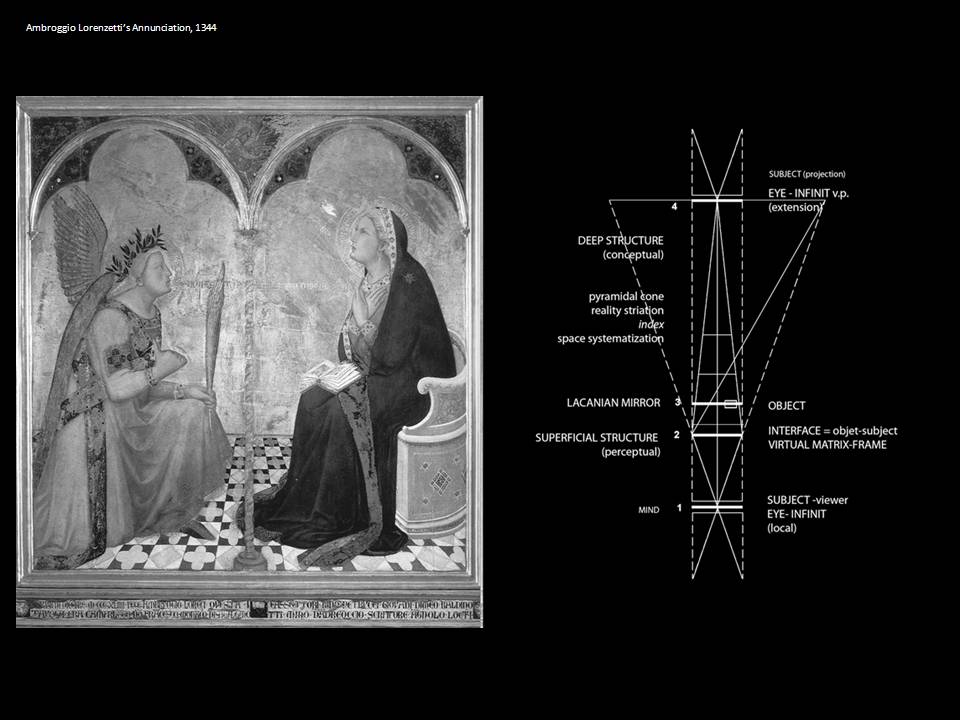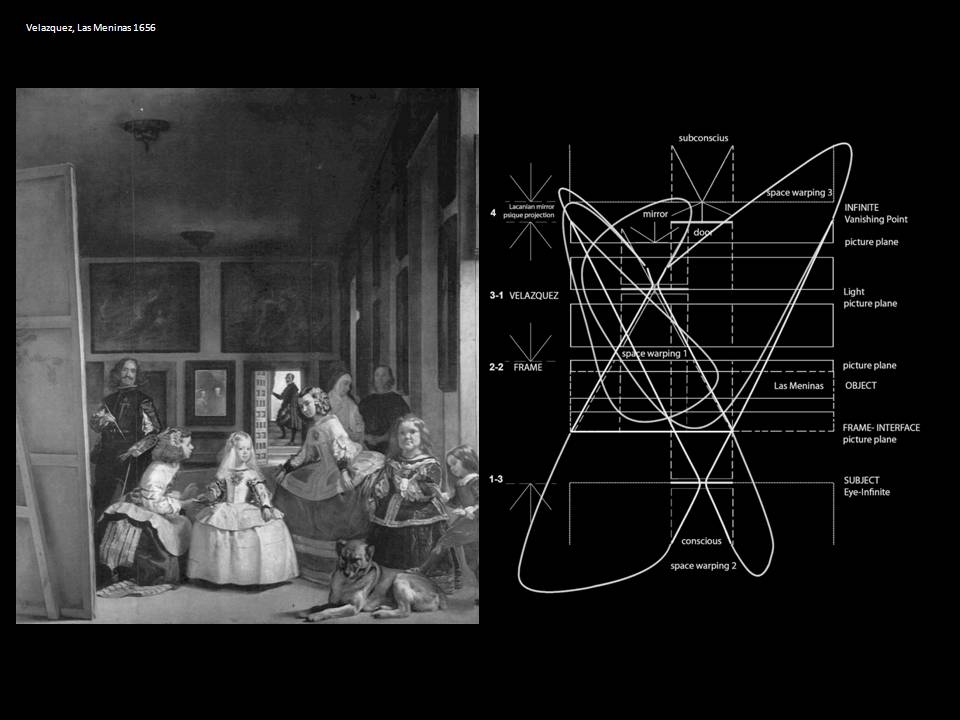THE STRIATION OF REPRESENTATION

Figure 1a,b
Annunciation,
Ambroggio Lorenzetti, painting and
plan diagram of implicit spatial relations. Diagrams by
Pablo Lorenzo-Eiroa.
Derrida’s concept of parergon questions the origin and the
frame of the work of art. For Derrida the content (ergon) of
the work is activated and determined by the presence of the
frame in which it is situated, questioning its origin.
Since Leon Battista Alberti wrote the first complete
treatise on perspective as a method, perspective has been
striating Western modern space, as proclaimed by Erwin
Panofsky . The growing array of interfaces that today
striate the work are layers where information is processed,
represented and ultimately presented through different
aesthetic ideologies. If the mediums of representation have
such a power to regulate the work, then representation is a
space of differentiation, where the content-ergon is
striated. This creates a responsive topological loop
involving form as content.
Panofsky presents Ambrogio Lorenzetti’s Annunciation of 1344
[fig. 1a], analyzing the presence
of the implied centered vanishing point that splits the
canvas activating the narrative between the two spaces. The
structure of the medium of representation performs in the
scene symbolically in the presence of the absence of the
infinite manifested by the vanishing point. This presence
activates the narrative of the painting, artistically
engendering within the medium an idea of God interceding
between the Angel and Mary, surpassing the representation of
an extrinsic content to the presentation of a content only
possible within this interface . [fig. 1b].
Las Meninas by Diego Velázquez (1656) [fig. 2a] contrasts
and displaces Lorenzetti’s linear perspective developing a
technical exposition of a paradoxical quality according to
John Searle. This painting invents a conceptual diagram that
challenges this linear structure, deconstructs perspective
as a medium and builds up a performative relationship
between the viewer and the work of art, inducing a
psychological and bodily affection . Foucault presents
Velázquez work as a suspension, but also a manifesto: the
death of representation…
The painting, the painting of the painting, the space of the
painting, the space of representation of the painting, the
multiple frames, the mirror, the background, the space
beyond the space, build up a layering of complex
pictorial-spatial problems that imply a conscious
architectural quality tensioning vertical picture planes and
the plan of the composition. First, in the pictorial plane
of his canvas, Velázquez projects what we cannot see,
inverting the point of view, confronting the observer.
Second, the viewer’s space is again engaged with the mirror
in the back that represents the omnipresent power of the
royal family, inverting directions with the vanishing point.
Third, behind the back plane-façade, the vanishing point
framed by the service door, points another virtual infinite
space. In coordination with Velazquez’s studio that is
represented again in the canvas above the door, the symbolic
structure of the unifying perspective of the space is
duplicated and another reflexive topological loop between
representations and realities is developed. This paradoxical
perspectival rupture exchanges deep structure and
superficial structure into a continuous topological
inversion, constructing a spatial warping between the
virtual spaces and the space of the viewer. Lastly, the main
vanishing point contrasts to multiple focus of attentions
and the inversed perspective cone, establishing a dialectic
between a stability performed by the unifying centrality of
the normal-structure perspective method and an instability
that displaces and produces movement to that structure. This
heterotopic space displaces the homogenization of the
representational structure that proposes the unifying
perspectival cone.
Simultaneously these perspective cones
are cut with perpendicular pictorial picture planes that
establish an architectural field of layered spaces that
reorganize such heterogeneous space, referencing Tintoretto's El Lavatorio (Venice, 1547) which Velazquez
previously brought to the Escorial and that acknowledges
Palladio's resistance to perspective in a dynamic form [fig.
2b]....

Figure 2a,b
Las Meninas, Velazquez, painting and plan diagram of
implicit spatial relations. Diagrams by
Pablo Lorenzo-Eiroa.
Article partially published in: